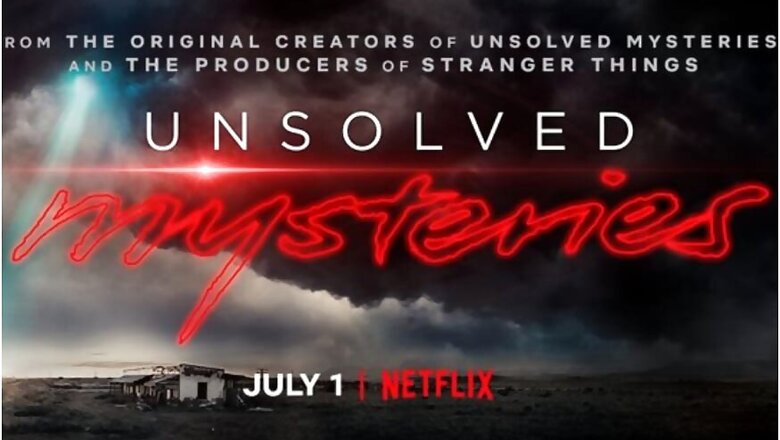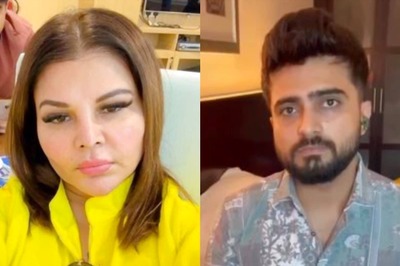
views
'Unsolved Mysteries', the alternately chilling and far-out docuseries, which returned to TV this week, began with a solved one.
In the fall of 1982, William Catterson, a New Jersey father of two, failed to return home from his fast-food job. His car was found, abandoned. A chocolate cake, an anniversary present for his wife, still rested on the passenger seat. Two years later, writer and producer Terry Dunn Meurer included his case in an HBO documentary: 'Missing Persons: Four True Stories'. Catterson, who had faked his own disappearance, saw it. He turned himself into police, then reunited with his family.
"And I was like, 'Wow, that's interesting'," Meurer said. She and her producing partner, John Cosgrove, began to imagine a series that would not only televise have-you-seen-this-person enigmas and criminological riddles but maybe also crack them, too.
'Unsolved Mysteries' debuted on NBC in 1988 as part of a late-80s tabloid TV boom and endured for decades on various networks and cable channels.
It had murders and missing persons. Also ghosts, Bigfoot and assorted UFOs. A cadaverous Robert Stack hosted. Eerie theme music gave even hardened viewers the heebie-jeebies. A pick-and-mix format alternated melodramatic crime stories and supernatural thrillers, arguably presaging both pulpy newsmagazines like 'Dateline' and paranoid dramas like 'The X-Files'.
Now Netflix has brought it back. The new 'Unsolved Mysteries', which reunites much of the original creative team, debuted Wednesday with a six-episode batch, to be followed by at least six more installments later this year. It arrives in an America it anticipated — a crime-obsessed, conspiracy-minded nation with increasingly subjective notions about truth.
The format has changed, but the blend of fact and folklore remains. It is a combination that risks trivializing actual crimes by juxtaposing them with wilder content and legitimizing the uncanny through proximity to fact. Not that the creators see it that way.
"We like the mix," Meurer said brightly. "We've always thought of ourselves as a mystery show, not as a true-crime show."
From the beginning, competing impulses powered 'Unsolved Mysteries': a crusading compulsion to seek for justice and a market-driven need to entertain. The show leaned heavily on reliable tabloid conventions — lost loves, missing heirs, unexplained deaths, medical mysteries — and many of the segments varied first-person interviews with best-guess reenactments, some of them lurid. Paranormal cases and alternate histories made the counterfactual (a conspiracy theory about Martin Luther King Jr.’s death, Bigfoot) into just another puzzle.
"We just came up with every single type of mystery that we could think of: UFO, paranormal, ghost stories, miracles, past lives, psychics,” Meurer said. “We just mixed it all in with the crime.”
On NBC, “Unsolved Mysteries” began with a disclaimer: “This program is about unsolved mysteries. Whenever possible, the actual family members and police officials have participated in re-creating the events. What you are about to see is not a news broadcast.”
So it was not news. Not exactly. But as crowdsourced detection, the series worked.
In the ’80s and ’90s, as an episode aired, viewer tips would pour into the show’s call center. Of the solvable mysteries — a missing child, say, or unidentified remains — the show counts more than 260 as resolved, a clearance rate of about 34%. (“Bigfoot isn’t necessarily solvable,” Meurer said.) Some of those solutions came via viewer tips. After a Friday night broadcast in 1988 about fugitives Missy Munday and Jerry Strickland, a flood of calls had already led to their arrest by Saturday morning.
After nine seasons on NBC, the show moved to CBS, then to Lifetime in an attenuated form, then to Spike, which repackaged old episodes and added Dennis Farina as a tan, tough-guy narrator. The Spike stint ended in 2010, but “Unsolved Mysteries” did not disappear. Its website and cold case forums remained open. Old episodes popped up, unofficially and then officially, on YouTube. Amazon began streaming them in 2017.
Meurer never gave up on a revival. “There’s always mysteries that need to be solved,” she said. When the hit Netflix drama “Stranger Things” premiered in 2016, she noticed tweets and Facebook posts comparing that scripted series, which is set in the ’80s and goes big on the paranormal, to “Unsolved Mysteries.” So she brought a pitch to its producers at 21 Laps Entertainment.
Shawn Levy, who founded 21 Laps, had watched the original “Unsolved Mysteries” in college, admiring the way it meshed genre mystery with character-driven story. “There’s a finite number of true iconic brands in the world, especially in the world of storytelling,” he said. “‘Unsolved Mysteries’ is a true icon.” (He also called it “the Holy Grail of IP.”) Levy, whose company has a deal with Netflix, came on as an executive producer, as did Josh Barry, president of 21 Laps.
Levy wanted to honor what he called the “DNA” of the original show, though longtime viewers will immediately recognize changes. Feeling that Stack, who died in 2003, was irreplaceable, producers omitted a host. Gone, too, is the party-platter format of the ’80s and ’90s, in which calamity followed calamity, separated only by commercial breaks. Now each episode, which runs 50 minutes, give or take, centers on a single mystery. There are no commercials.
These episodes — three unexplained deaths, one missing person, one wanted man, one paranormal phenomenon — move closer to traditional documentary, with fewer reenactments and a greater emphasis on interviews and archival sources. The show assumes a somewhat more sophisticated viewer with a far longer attention span. One episode — a family annihilation chiller — is presented almost entirely in French, with English subtitles.
And the producers hope that a platform like Netflix, with its global reach and its more than 180 million subscribers, many of them now homebound, may lead to more solutions.
“The reach is so wide,” said Marcus A. Clarke, who directed several episodes of the new version.
That reach prodded Angel Rivera to participate in the first episode, “Mystery on the Rooftop.” In 2006, his brother, Rey Rivera, went missing. His body was found a week later in the conference room of a Baltimore hotel. A murder or a suicide? The medical examiner could not say.
“It’s not something that I ever readily shared with anyone,” Angel Rivera said. But he trusted the producers and described the interviews that Clarke had conducted as therapeutic.
“There was a sense of peace doing it,” he said. And the show, he believes, might prompt someone to come forward with information.
“We’ll get it out to more ears and eyes than we could ever possibly imagined,” he said. “For my parents, even for me, there’s that closure that we’re all looking for.”
Rivera did not mind that the same viewers who will scrutinize his brother’s death can also watch “Berkshires UFO,” an episode about close encounters in the Berkshire mountains in 1969. “I think it falls in line with what the brand is about,” he said.
In 2020, when politicians knowingly circulate alternative facts and conspiracy theories trend on TikTok, what does it mean for that brand to take a flexible approach to observable reality? “Unsolved Mysteries” did not create this fungible, disingenuous moment. But a show that puts aliens on the same epistemological footing as a murdered family does meet it.
This is not necessarily an act of bad faith — Meurer absolutely believes in the paranormal. “I’ve always felt that way, my whole life,” she said. And Clarke, who directed “Berkshires,” is a UFO enthusiast. He mentioned The Times’ reporting on the Pentagon’s recent release of three videos, filmed by Navy pilots, that show unidentified aerial phenomena.
“If at this point people don’t believe or understand that these things are real, they are in denial,” he said.
Levy, who described himself as “slightly to the skeptical end of that sliding scale,” enjoyed “Berkshires UFO.” But when pushed, he said he felt less certain about the show’s accommodating approach to the supernatural. “That is something that needs to be considered moving forward,” he said.
Another potential problem, for viewers if not necessarily the producers, is the show’s relationship with law enforcement. Cops were not necessarily the series’ heroes. After all, if a case made its way to “Unsolved Mysteries,” police had probably failed in some way.
But agencies have historically suggested mysteries to the show’s producers and sent officers to vet tips. Like the recently canceled “Cops,” the series makes an implicit argument for law and order with its envisioning of a dangerous, anarchic world.
“We’ve always had a great reputation with law enforcement,” Meurer said.
Still, an episode in this new series, “No Ride Home,” explores a botched police investigation into what may have been a racially motivated crime. In 2004, Alonzo Brooks, a young Black man, disappeared after attending a party. After a police search failed, a search led by friends and family located his body.
A cause of death was not determined. In June, spurred by inquiries from “Unsolved Mysteries,” the FBI reopened his case, offering a $100,000 reward.
“We’ve been seeing a lot of people being kind of brought to justice from old cases, and this is one that really deserves it,” Clarke said. “The family deserves it.”
Cynthia Bowles, a longtime story producer, thinks that the Brooks case could be solved. She also feels hopeful about the murder of Patrice Endres (the subject of the episode “13 Minutes”) and the disappearance of Lena Chapin (“Missing Witness”).
“They could all shake loose,” she said.
Ethical complications will not matter so much if the right tips come. If Brooks’ family — or Rivera’s or Endres’ or Chapin’s — gets answers, who will care about wiggly truth value or an outlook that sees the world through a camera lens, darkly?
“‘Unsolved Mysteries’ has always represented hope,” Meurer said. “That’s why we do the show: The hope is that we’re going to solve these cases.
“To me,” she added, “that mitigates the darkness.”

















Comments
0 comment